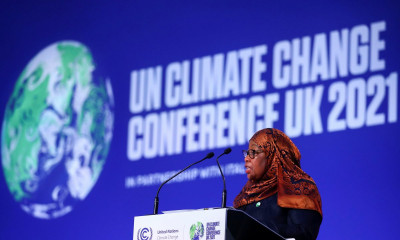The mining sector is an important sector that can either facilitate or hinder progress. While the mining sector can promise economic development, job opportunities, business development, increased revenues and infrastructure linkages, it also has the potential to impact negatively on the SDGs through environmental degradation, displacement of populations, worsening economic and social inequality, gender-based violence, corruption, health and human rights degradation.
Despite being a potential threat to the realisation of SDGs, the mining sector has the potential to contribute to all 17 SDGs. SDG 1, which focuses on social inclusion through the eradication of poverty and inequalities, is important in the South African context of mining. Our colonial and Apartheid history dispossessed many black people of their land and human rights for mining and the legacy of dispossession is still blatantly alive. Additionally, SDG 16 recognises peace, justice and strong institutions as equally important. SDG 16 requires the mining industry to ensure transparent reporting of revenue and to support representative decision making of citizens and communities to harness the positive benefits of mining. This is a challenge across the African context. The African Mining Vision (AMV) aims to address these challenges and I had the opportunity to witness the key debates that surround it at the Alternative Mining Indaba earlier this year in February 2017.
The 8TH AMI was themed ‘Making Natural Resources Work for the People: Domestication of the African Mining Vision (AMV) from Vision to Reality.’ The AMV, adopted by African Heads of State at an African Union Summit in 2009, aims to achieve a holistic mining approach that moves away from profit focus towards one that integrates mining into development policies at all governance levels to include social and environmental impacts of mining as required by the SDGs. The old paradigm focused largely on tax collection for governments and profit for mining companies. In this context, social and environmental impacts of mining often don’t receive sufficient attention and this is problematic.
Of primary importance is the question of how the AMV can be implemented at the local level. The AMV aims to ensure mining activities contribute to local development and accrue real benefits whilst ensuring environment protection of local communities and their resources. While the AMV is ambitious and contains commendable development-oriented rhetoric, the success of the vision depends heavily on local participatory structures. African local participatory structures have in the past have often been shown to be unreliable and an initiative like the AMV is potentially subject to failure. The effectiveness of these participatory structures is questionable and under serious scrutiny. For example, one of the participants at the AMI claimed frameworks such as the AMV are elite-led projects which under represent communities. One must then consider the implications that are likely to follow from under-representation at the local level.
How is it possible to make resources work for the people at a local level if democratic and social institutions require strengthening? The South African Institute of International Affairs (SAIIA) hosted a roundtable discussion entitled ‘Trust as a Mechanism for Employee and Community Empowerment in South African Mining’. Dr Sonwabo Mnwana, a researcher from the University of Witwatersrand, highlighted that local chiefs are the primary custodians of communal land and disputes. Their interests, however, are not always aligned with the community’s and this can lead to conflict and wasteful expenditure. Dr Mnwana further highlighted the ambivalent nature of the word “community” and contends that it implies a sense of cohesion and uniformity that is often not there in reality. The implication, of course, is that traditional leaders alone cannot effectively represent the needs of the community.
Furthermore, there is an additional concern that women are most likely to be excluded from decision-making processes. Although policy prescribes some percentage of gender-based representation, traditional patriarchal values may trump the voices of women, resulting in passive participation. Women also tend to be excluded from land claims in mining areas. This is a violation of SDG 1 and SDG 5, and effectively undermines of the progress towards equality. It is difficult to understand how resources will work for the “people” if participation structures in mining communities are not improved to hold mining companies accountable for social, economic and environmental impacts of mining projects.
I also attended the SAIIA Change Makers Forum which dealt with how mining relates to the SDGs. One of the issues that came up at the forum was the question around resource beneficiation in mining for job creation in the local community. Ben Turok, a well-known minerals economist in South Africa, advocated for adding value to mineral resources to strengthen value chains. He argues that our resource wealth should not be extracted unsustainably and without any positive economic impacts on communities. Job creation and skill improvements should be at the centre of industrial mining benefits so that resources work for the people. Converting our own resources into more economically viable products should therefore be made a priority.
Turok also noted that the production of engineering equipment has declined in South Africa. This is concerning and hints at South Africa’s disastrous education and skills shortage. Investments in education need to be made to address the lack of skills in our key resource related industries. African countries should be masters of their craft, and we shouldn’t be exporting and buying back our own resources. We could be benefiting far more from our resources if we processed them here and if our mining industry was more effectively linked with local manufacturing and other sectors.
Our current mining sector configuration reminds me of the dependency theory pioneered by scholars like F.H. Cardoso in which elites cooperate to maintain an unjust, cooperative and corrupt international system. Our leaders need to end exploitative cooperation so that we can achieve longer term gains. To enable this, local participatory structures need to be improved to ensure that mining benefits are received by the masses and not just concentrated in the hands of elites and politicians.
Ultimately, vibrant democratic and participatory local structures will empower communities to hold local and national leaders to account. Strengthening accountability structures will pressurise leaders to be inclusive and transparent and progress will be made to achieve SDG 1 and 16 simultaneously. In addition, to steer mining companies to create a coherent developmental agenda as prescribed by the Constitution thus making mineral resources work for the people. The failure to do this is partly a failure to implement the SDGs.








